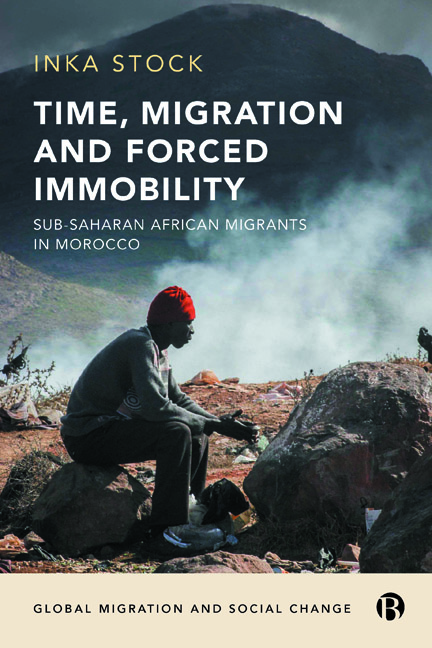Book contents
- Frontmatter
- Global Migration And Social Change
- Contents
- List of Figures and Tables
- Acknowledgements
- Series Preface
- 1 Introduction
- 2 EU Externalization Policies and their Impact on Migrants in Morocco
- 3 Travelling Adventures: Migration as an Existential Quest
- 4 Arriving in Morocco: Becoming Trapped in a Context of Uncertainty
- 5 Facing Time and the Absurd
- 6 Migrant Communities in Morocco
- 7 Waiting in Desperate Hope
- 8 Conclusion
- Bibliography
- Index
1 - Introduction
Published online by Cambridge University Press: 30 April 2022
- Frontmatter
- Global Migration And Social Change
- Contents
- List of Figures and Tables
- Acknowledgements
- Series Preface
- 1 Introduction
- 2 EU Externalization Policies and their Impact on Migrants in Morocco
- 3 Travelling Adventures: Migration as an Existential Quest
- 4 Arriving in Morocco: Becoming Trapped in a Context of Uncertainty
- 5 Facing Time and the Absurd
- 6 Migrant Communities in Morocco
- 7 Waiting in Desperate Hope
- 8 Conclusion
- Bibliography
- Index
Summary
Sub-Saharan African migrants in Morocco
The first Sub-Saharan African migrant I ever met in Morocco was in 1999. He was sitting next to me on a bus when I was travelling from Tangier to Tetuan, two cities on Morocco's Mediterranean coast. While we were chatting, he explained to me that he had been living in both Morocco and Spain for several years, depending on where he could get seasonal work. He also said that irregular border crossing had never been an insurmountable problem in the past, but that in recent years increasing controls in the Strait of Gibraltar were making it very difficult.
At that time I lived in Rabat, the capital of Morocco, and worked in the social sector. Since the year 2000, I had noticed that non-governmental organizations (NGOs) were beginning to draw attention to the humanitarian problems of Sub-Saharan African migrants in Morocco, particularly those who were continuing on and arriving at Spanish shores. Media reports about irregular boat people who attempted to reach Spain were multiplying. Whereas some years before, such reports had focused on irregular migrants from Morocco, now, images of half-drowned Sub-Saharan African migrants being assisted by tourists on the crowded beaches in Andalucía were frequently featured in Spanish newspapers. By the time I left Morocco in the summer of 2001, the boats with irregular migrants from Morocco's northern coasts were filled almost exclusively with Sub-Saharan African migrants who had replaced the mostly Moroccan migrants that had boarded them until then (Belguendouz 2009).
When I returned to live in Morocco at the end of 2007, the situation had changed. Rather than being a topic rarely talked about in government circles and NGOs, African migrants living in precarious conditions in Morocco had become a key area of interest for many organizations, including certain local NGOs and the academic community in Rabat and beyond. Migrants were living in marginalized areas, often deprived of the most basic rights and services, suffering exclusion and poverty. Even though it appeared that the overall number of migrants present in Morocco had not changed significantly since 2000, migrants were more and more visible in Rabat and Casablanca, and less frequently concentrated in the woods surrounding Oujda, Ceuta, Tangier and Melilla, the places from where the inflatable zodiacs and fishing boats used to leave for Spain.
- Type
- Chapter
- Information
- Time, Migration and Forced ImmobilitySub-Saharan African Migrants in Morocco, pp. 1 - 22Publisher: Bristol University PressPrint publication year: 2019

